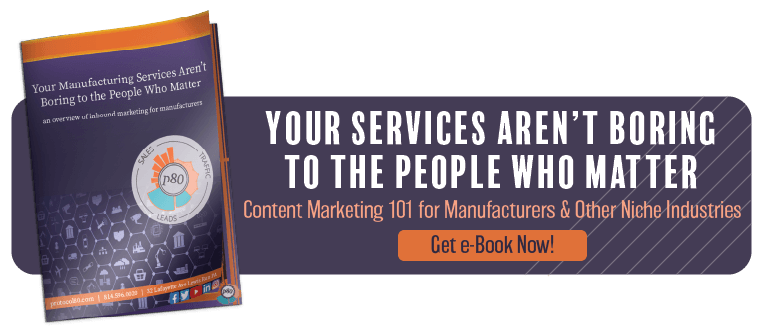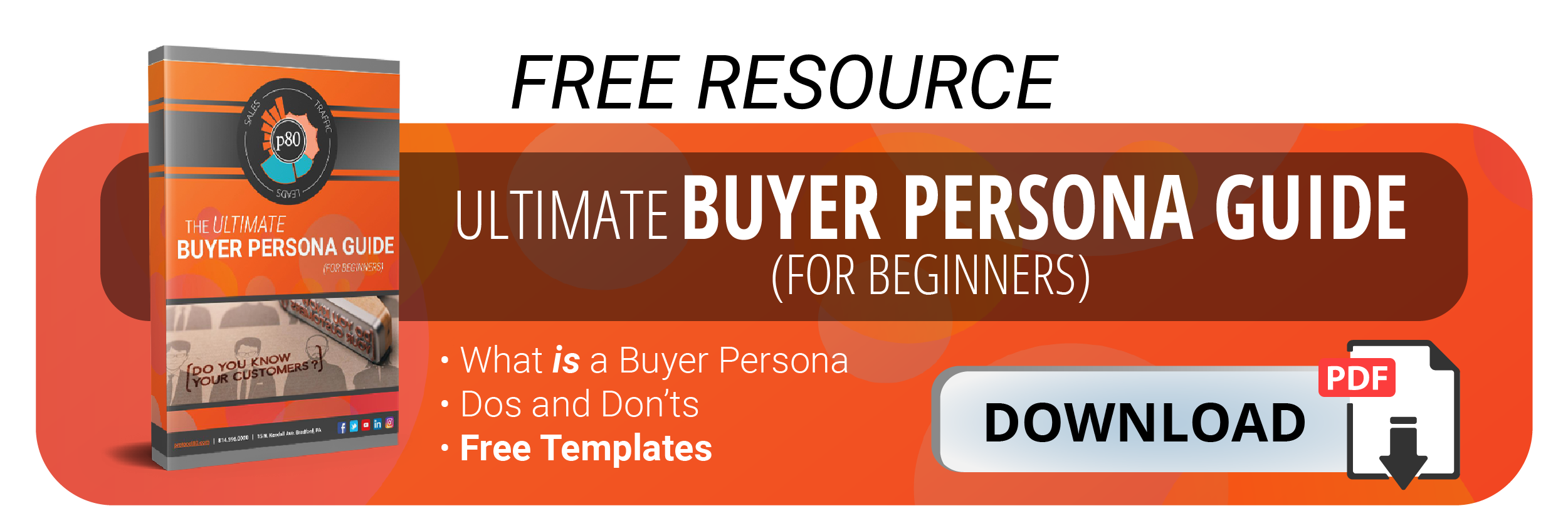Inbound Marketing Blog
for Manufacturers and Healthcare Companies
Increase Organic Traffic With 'Boring' Industrial Content Marketing

Everyone wants the spotlight on their business. Online, the easiest way to earn one is by becoming “findable” in Google Search and “clickable” in email and on social media.
Sadly, many niche companies (think B2Bs and manufacturers) are afraid or unwilling to put themselves out there. They think inbound and content marketing are for Wendy’s and GE, not for little, ol’, boring them. They fear trade shows and cold calling are the only things that will ever generate contacts for them, because their product “just isn’t marketable” online.
If this is you … you’re living a lie! Industrial content marketing is a real thing. There are B2B digital marketing agencies who literally only exist to serve this niche sector.
So, if they can do it, why can’t you? We’ll present eight ways you can build your “boring” brand into a spotlight that’s also a green traffic light for great-fit leads:
‘Hi, I’m Boring. Will Industrial Content Marketing Still Work?’
Hi, Boring! First off, stop calling yourself that. Surely someone cares about your product, or your company wouldn’t exist.
Also, let’s clarify that we’re talking about increasing traffic organically (without paying). That means paid Google and social ads don’t count.
The short answer is: Yes, mundane, niche products can still grow a difference-making following, just like massive, mainstream brands (think Apple) can.
“My company isn’t exciting” or “My product isn’t sexy” isn’t an excuse for poor organic traffic. Your company still has a story to tell and a “why” (your mission statement). Your ideal customer and their company have stories and “whys” too, and you’re free to model what’s working for them.
We’ve seen niche content marketing strategies grow monthly website traffic from under 50 to over 15,000. The company we’re talking about? It manufactures small, round metal things. Not very exciting. (In a bit we’ll talk about how you can make them exciting.)
8 Ways to Increase Organic Traffic for Your Boring Product/Service
Increasing website traffic organically is a matter of perfecting both your message and your megaphone. In the case of B2B niche marketing, consider these content styles and delivery methods:
- Buyer research
- Trend pieces
- How-to content
- Comparison guides
- Videos of product/process
- SEO
- LinkedIn posting
- Newsletter emails
1. Buyer Research
Tip #1 lays the foundation for the next eight.
If you’re not getting traffic to your website, it’s not necessarily because your industry is too bland. You may be targeting the wrong audience in the wrong place or with the wrong type of content.
To truly understand how to target a niche market, revisit your company’s vision of its “ideal buyer.” Re-workshop this vision with your marketing, sales, and customer service teams -- and any other stakeholders. Document the following:
- Your B2B buyer persona: A semifictional portrayal of your ideal buyer, including their demographics, job role, goals, habits, & more
- Your B2B customer journey: The steps your ideal buyer takes from the time a problem/opportunity develops to the final purchase
After you’ve refreshed your company’s perspective, it’s time to get the buyers’. Interview as many of your current “great-fit” customers as possible and ask discovery questions.
Real-Life Niche Marketing Examples:
- “What challenges or opportunities led to you seeking us out?”
- “What social media and industry websites do you visit to educate yourself?”
- “What factored most into your purchasing decision with us?”
From there, match all these amazing insights with your company’s goals and create a calendar of content that better addresses your buyer’s needs. With a better understanding of your persona, you can more directly speak to their concerns and goals -- with more relevant keywords, content topics, and content distribution methods. It allows you to use the empathy-based storytelling that attracts attention in a “boring” industry -- and increases views of your website content.
2. Trend Pieces
If something exciting is happening in your industry that will open opportunities for your potential customers, share it! If there’s a looming issue in your customers’ own industry that’s adjacent to your solution, share that too.
Blogging about industry news and trends falls firmly in the Awareness stage of the B2B buyer’s journey. The buyer is just beginning to realize their problem and taking to Google or social media to define it.
By sharing your expert take on a developing situation, you can build authority and trust in readers’ eyes. These types of articles tend to do well on social media, a valuable form of organic traffic.
Real-Life Niche Marketing Examples:
- “What Does the 'Electrification of Transportation' Mean?” (Horizon Technology)
- “Additive Manufacturing … Revolutionizing the Dental Industry” (GE Additive)
- “Hospitality Design Trends for all Generations of Guests” (Artone)
Best of all, if the reader needs to make a purchase someday, they may remember your brand’s expertise and give you a call.
3. How-To Content
If what you offer is niche or technical, your customers may benefit from instructional content.
Look at the way search queries have changed in the past 5 years. Many engineers and other problem-solvers are asking Google for instructions or guidance. Writing “how-to” content is an easy way to rank for the very question-based keywords these researchers are now directly asking Google Search.
This doesn’t just mean writing “How to Use Our [Product/Service X]” 100 times over for everything your company offers. Those can be useful, but this isn’t all about you!
Instead, take a bird’s-eye approach and think of the broader questions your buyers have for which someday you could be the solution. Most how-to content is about educating your audience, which builds trust and brand awareness. Most industrial sales cycles are long, so this long-term approach is more about keeping your expertise top-of-mind until that researcher is finally ready to buy.
Real-Life Niche Marketing Examples:
- “How to Achieve Zero Defects in Your Electronics Build” (Matric Group)
- “4 Ways to View & Print Oracle Report Output When Working From Home” (STR Software)
- “5 Steps to Convert Your Die Casting Application to Powder Metallurgy” (Horizon Technology)
Side note: Notice how that last one targets “purchase-intent” readers while still being educational and customer-focused? Much more useful than an obnoxious sales pitch.
How-to content isn’t just a written-word thing -- it’s ideal for video as well. If your product/service is highly visual, a visual explanation is only going to help.
4. Comparison Guides
Naturally, when an engineer or purchasing agent researches a problem online, part of that research includes comparing Solution A vs. Solution B. This is your opportunity to be the objective voice of reason.
If you’re struggling to develop B2B blog post ideas, comparing options is a great start.
Real-Life Niche Marketing Examples:
- “4 Types of Flexographic Inks & When to Use Them” (Luminite)
- “Fire-Protective vs. Fire-Resistant Glass” (New Angle Beveling)
- “How to Choose the Right Track for Your Compact Track Loader” (Caterpillar)
Again, a disclaimer: “Why Our Product Is Better Than Competing Products” shouldn’t be the beginning and end of your comparison content. Not all potential buyers are ready to buy just yet. If you do create content that directly compares your solution to another, at least be transparent and explain you might not be the ideal solution too. This helps filter bad-fit leads and keeps them from becoming unhappy customers.
 5. Videos of Product/Process
5. Videos of Product/Process
We’d be failing you if we didn’t mention video again -- more people are consuming manufacturing/industrial video marketing than ever.
Even boring products may have been born from a cool-looking process, or have an exciting end-use. If you can’t fathom what to talk about on video, let your process do the talking
Real-Life Niche Marketing Examples:
- Demo of your product/service in action (Dahlstrom Roll Form)
- Step-by-step of your product being made (Monofrax)
- Virtual facility tour (Standard Textile)
So, how does this relate to getting people on your actual website? When you post these videos on YouTube, include links and calls-to-action to your website, both directly in the video and in its written description. Share your videos on social media to further grow your organic traffic.
6: SEO
You may have noticed the first several tips covered what to create. The next few are just as important -- they cover how you help buyers find your content.
SEO, or search engine optimization, is the process of improving your site’s visibility in search engine results via organic (free) methods. SEO is a factor in virtually every element of a B2B digital marketing strategy.
- Keywords -- Each page you create should have a primary keyword centered around its topic. (Example: This page’s keyword is “industrial content marketing.”) You should also include supporting keywords that further clarify to Google what your page is about. Think about what your audience might be typing into Google Search to research the problems you can solve!
- Linking -- Connecting an internal "web" of relevant linking on each page helps Google understand what and how pages relate to each other. From a UX standpoint, it also creates convenient opportunities to visit other pages on your site (therefore increasing the “trustability” factor that influences Google rankings). You should also pursue "backlinks" by sharing your content with people and websites likely to link back to it.
- Technical SEO -- This is the nerd-level stuff that ensures your site is findable and glitch-free. Common technical SEO issues include site URL/structure errors, broken links and media, and slow loading speed. If ignored, these issues can keep Google from finding (and ranking) your site or frustrate visitors into leaving your page.
(p80 Tip: Honestly, there’s so much to SEO that you’re best off reading this separate article on why you’re not ranking in Google. Don’t take SEO as a nice, little “side thing” -- it’s an entire beast of its own.)
7: LinkedIn Posting
“We do social media marketing for manufacturers/industrial companies” -- this statement often earns us an eye roll. After all, who gets on social media to gab excitedly about self-lubricating plain bearings or wastewater management best practices?
Content marketing for boring industries still requires being where your buyers are. And they’re almost certainly on LinkedIn (and other social platforms, maybe).
Traffic will take much longer to pick up if you rely only on SEO for brand visibility. Get out there and share your content on LinkedIn and wherever else your buyers seek education.
As always, “education” is the important word here. At least 90% of your posts should be educational, not promotional. Share links to your content and “hook” the reader with a reason why they should click (i.e. their pain point). Include relevant hashtags to help your target audience find the article more easily.
(p80 Tip: For example, we might promote this very article with #B2Bmarketing, #contentmarketing, and #bloggingtips.)
Your mileage with social media will vary based on your industry and your buyers’ habits, but at the very least, look into how other B2B marketers and sellers use LinkedIn.
8: Newsletter Emails
There’s a misconception among some that email marketing is dead. While spammy, sales-y tactics no longer fly (Did they ever?), there are plenty of successful examples of email marketing for manufacturers and other niche industries.
Make sure all of your website pages have lead-capture forms, including some that specifically promote newsletter subscriptions. All of these captured leads should go into a contact list for your newsletter. (Do not add any purchased or otherwise non-consenting contacts).
This way, you don’t need to worry about readers finding your topics boring -- they’ve already shown interest before! Keep nurturing these leads by feeding them useful tips, data, and solution comparisons. Each click inside your email is another organic traffic visit.
Mind Over (Subject) Manner
Your mission in B2B content marketing is this: Create material that helps buyers do their jobs. If you can do that, they’ll love you, and consider you a trustworthy -- and purchase-worthy -- source someday.
That, ultimately, is how you increase not just traffic, but also leads and sales -- whether you sell iPhones or public bathroom sanitizers. At its core, content marketing for manufacturing companies and other niches should function the same as any good marketing: providing customer-focused value.
To see more of what successful content looks like, don’t miss this free e-book -- specially visualized for niche B2B marketing:
Our Blogs, Direct to Your Inbox!
How to Audit your Online Marketing
If you are executing digital marketing, congratulations! You are most likely already one step ahead of your competition, and making strides to meaningfully connect with prospects online. But, how do you know if you’re seeing continual success year over year, and improving your metrics?
Without the tools in place to analyze and benchmark your efforts, it is impossible to scale your online marketing and ensure continuous success.



